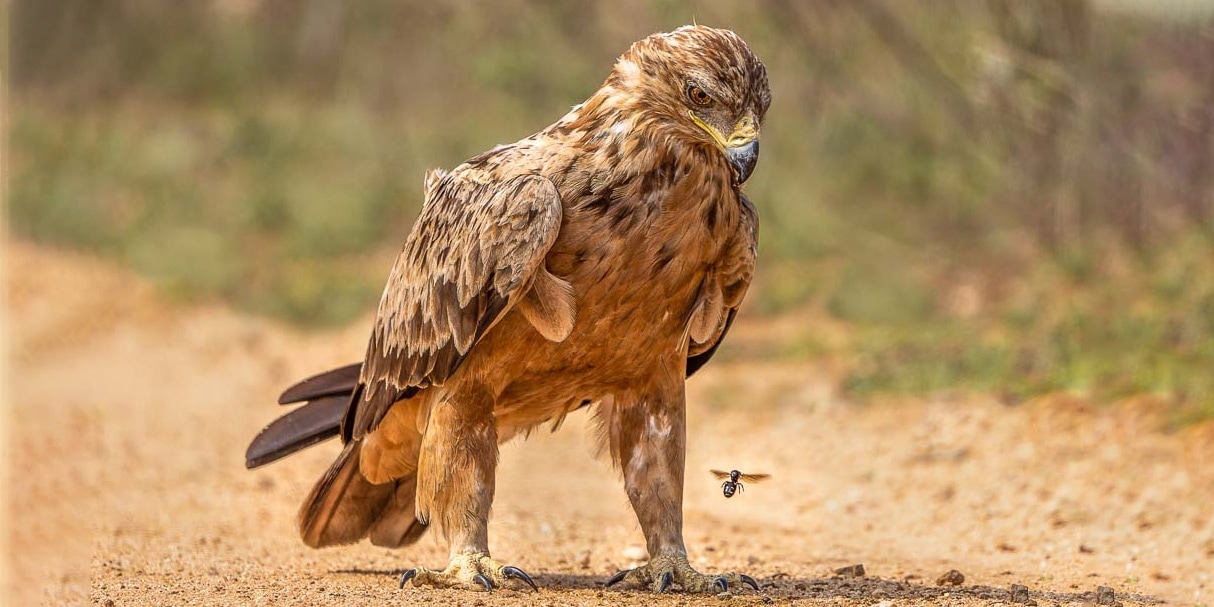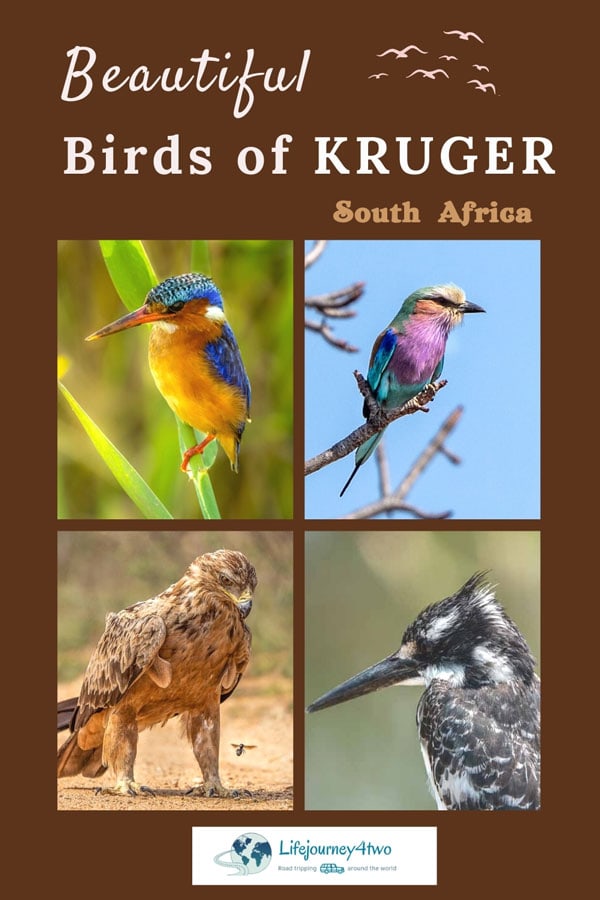Using the words of Brian Jackson, an award-winning freelance journalist with a passion for African travel and wildlife,
“Everything in Africa bites… but the safari bug is worst of all”.
No truer words have been spoken, and it’s a bug I’m happy to say I’ll never want to shake off.
Waking up each day in Kruger on a self-drive safari is a happy day. We were fortunate to experience amazing opportunities to watch, learn and photograph these spectacular birds in Kruger National Park.
There is much to see in Kruger National Park, offering a sanctuary to its 148 recorded mammals, 114 reptile species, 50 fish species and over 500 different species of bird.
With so much wildlife calling this home, it’s no wonder people flock here from around the globe to witness it for themselves. This is a paradise for a birder.
During our three-month adventure in Kruger, every sunrise brought unforgettable encounters with its feathered inhabitants.
Join us as we discover the treasure trove of birds of Kruger National Park as seen through our lens including our own Kruger National Park birds photos.

Quick Guide: Birds in Kruger National Park
If you’re keen to check out the birds in Kruger National Park but don’t have much time, here’s the quick lowdown on the birds you can spot and some tips to make the most of your bird-watching trip.
Birds to Spot:
Kruger’s Big 6:
- Kori Bustard,
- Martial Eagle,
- Lappet-Faced Vulture,
- Pel’s Fishing Owl,
- Saddle-Billed Stork,
- Southern Ground Hornbill.
Noteworthy Mentions:
- Lilac-breasted roller, European Roller, Southern Red-Billed and Yellow-Billed Hornbills, African Grey Hornbill, White-Fronted Bee-Eater, Malachite Kingfisher, Giant Kingfisher, Pied Kingfisher, Brown Hooded Kingfisher.
Raptors:
- African Fish Eagle, Tawny Eagle, Bateleur, African Hawk Eagle, Brown Snake Eagle, Yellow-Billed Kite, African Harrier Hawk, Verreaux’s Eagle Owl, Pearl-Spotted Owlet.
Others:
- Vultures (White-Headed, White-Backed, Hooded), Green Wood Hoopoe, Blue Waxbill, African Spoonbill, White-Bellied Sunbird, Yellow-Billed Oxpeckers, Grey Heron, Lesser Striped Swallow, Black-Headed Oriole, Crested Barbet, Green-Winged Pytilia.
Quick Tips:
- Photography: Utilise long lenses for birds wary of proximity. Keep movements minimal and patience high. Early mornings and late afternoons are best to see diurnal birds active.
- Apps for Identification: KrugerExplorer for detailed bird and animal info; Tracks4Africa for navigation within Kruger.
- Vehicle Tips: Keep speeds low to spot and photograph birds from your vehicle. Use rest camps for closer encounters on foot.
- Best Season for Birding: Dry season for clearer visibility; however, Kruger’s diversity ensures year-round birding opportunities.
Conservation Status: Many of Kruger’s birds are classified from near threatened to endangered. Your visit and interest contribute to their conservation.
Plan Your Trip: Consider car or campervan hire for flexibility; ensure travel insurance is in place. For an enriched experience, book accommodations that offer proximity to nature.
Experience Beyond Birds: Kruger is a haven for wildlife, offering sightings of mammals, reptiles, and more. Embrace each moment, whether through the lens or with your own eyes.
Remember: Each bird sighting is unique, contributing to the unforgettable tapestry of Kruger National Park’s biodiversity.
Rare Birds in Kruger National Park or the Most Sought After?
SANParks, the official site for South African National Parks, lists the holy grail of Kruger’s six most sought-after birds visitors want to see as the ‘Big 6‘. It is rare for visitors to complete the six sightings on the Big 6 list.
Why?
Well, 5 out of 6 birds are diurnal or active during the day however, Pel’s fishing owl is nocturnal and roosts during the day. Not only is this owl stationary, but the plumage is predominantly a rufous-brown, making it especially hard to spot in foliage.
Five species of the Big 6 birds are classified as either endangered or near threatened, and in my books, that qualifies them as a rare enough species.
We were excited to capture five out of six of Kruger’s Big 6. These birds are:
- ✅ Kori bustard
- ✅ Martial eagle
- ✅ Lappet-faced vulture
- ❎ Pel’s fishing owl (still on our to-see list)
- ✅ Saddle-billed stork
- ✅ Southern ground hornbill
Planning a Trip to South Africa?
- 🚗 Hiring a car? We recommend getting a quote from DiscoverCars
- 🚐 Hiring a campervan? We recommend Motorhome Republic
- ⛑ Arranged your travel insurance? Compare quotes from World Nomads & Safetywing
- 🪪 Order your International Driver’s Licence online here
- 🏩 Booked your accommodation? We use Booking.com to find the best deals
- 🐾 Is someone pet-sitting for you? 🐾 We use and love TrustedHousesitters
- (Get 25% off at checkout for new memberships with our discount code: LIFEJOURNEY25)
Kori Bustard – The Heaviest of the Big 6
The Kori Bustard is Africa’s heaviest flying bird, with the scales tipping at 19kg. The male’s wing span is an impressive 2.3m to 2.8m, whilst the female is somewhat less at under 2.0m.
It needs the massive wings to take a rather reluctant flight only for a short distance.

Often on safari, we would close in on a Kori Bustard to attempt some close-up shots however, we could never get close. The bird would veer away, ensuring it kept a good distance from us.
This bird is classified as near threatened.
Photography Tip: Kori Bustard
Use a long lens and try to keep at least 30m from the Kori Bustard to prevent it from scaring. The bird is nearly always moving, so we found it best to keep our vehicle moving slowly in unison with it. Stopping our 4×4 when needed to grab some quick shots.
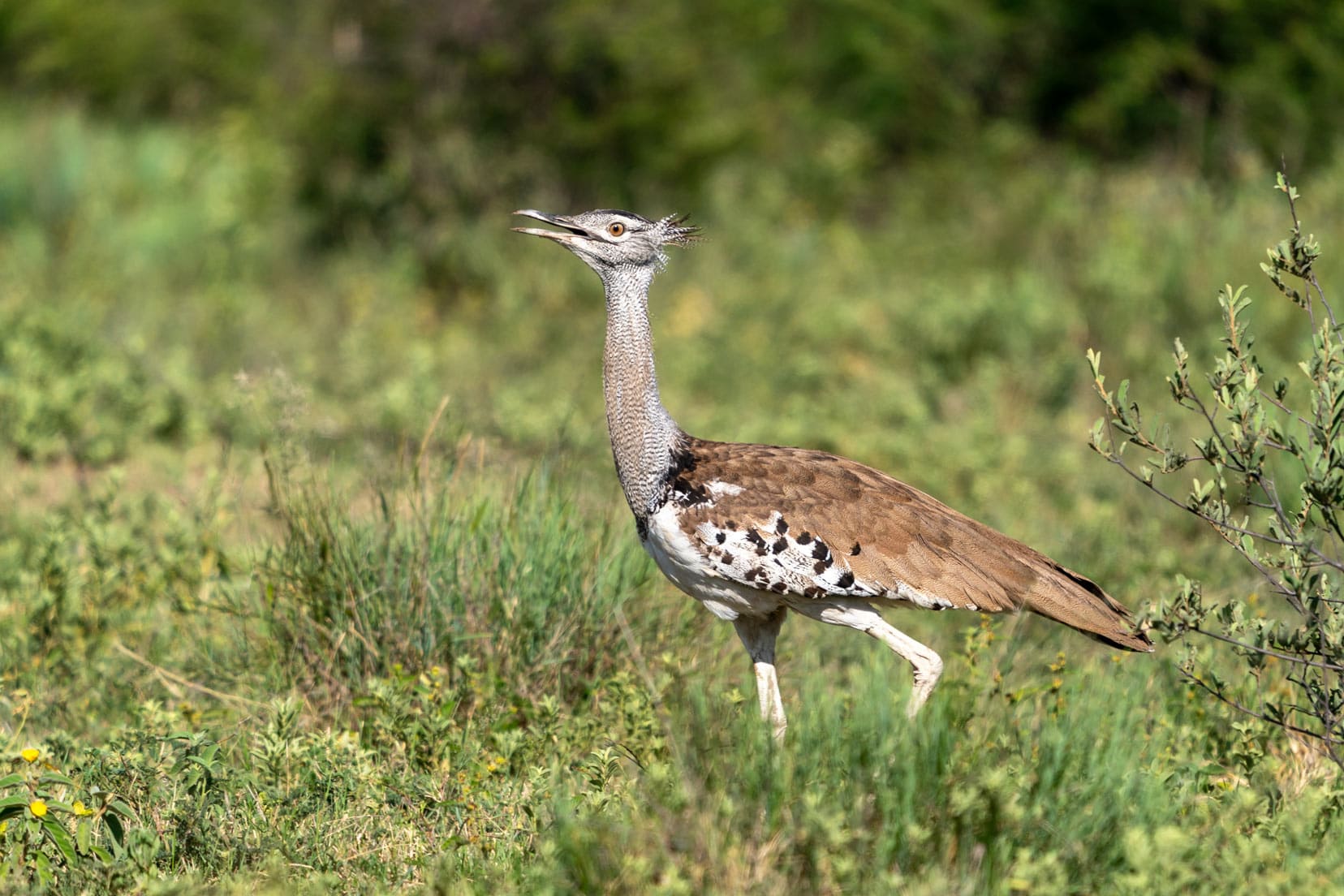
Martial Eagle – The Mightiest Predator of the Big 6
The Martial eagle, with large wingspans of up to 2.6m, is the most formidable of hunters in this list of Big 6. It is Africa’s largest eagle and an apex predator in its ecosystem.
This eagle commonly attacks from a vantage point high in the sky, descending at speeds up to 230km/hr, striking and often killing its prey on impact. The bird’s sharp talons and beak are perfect weapons of choice.
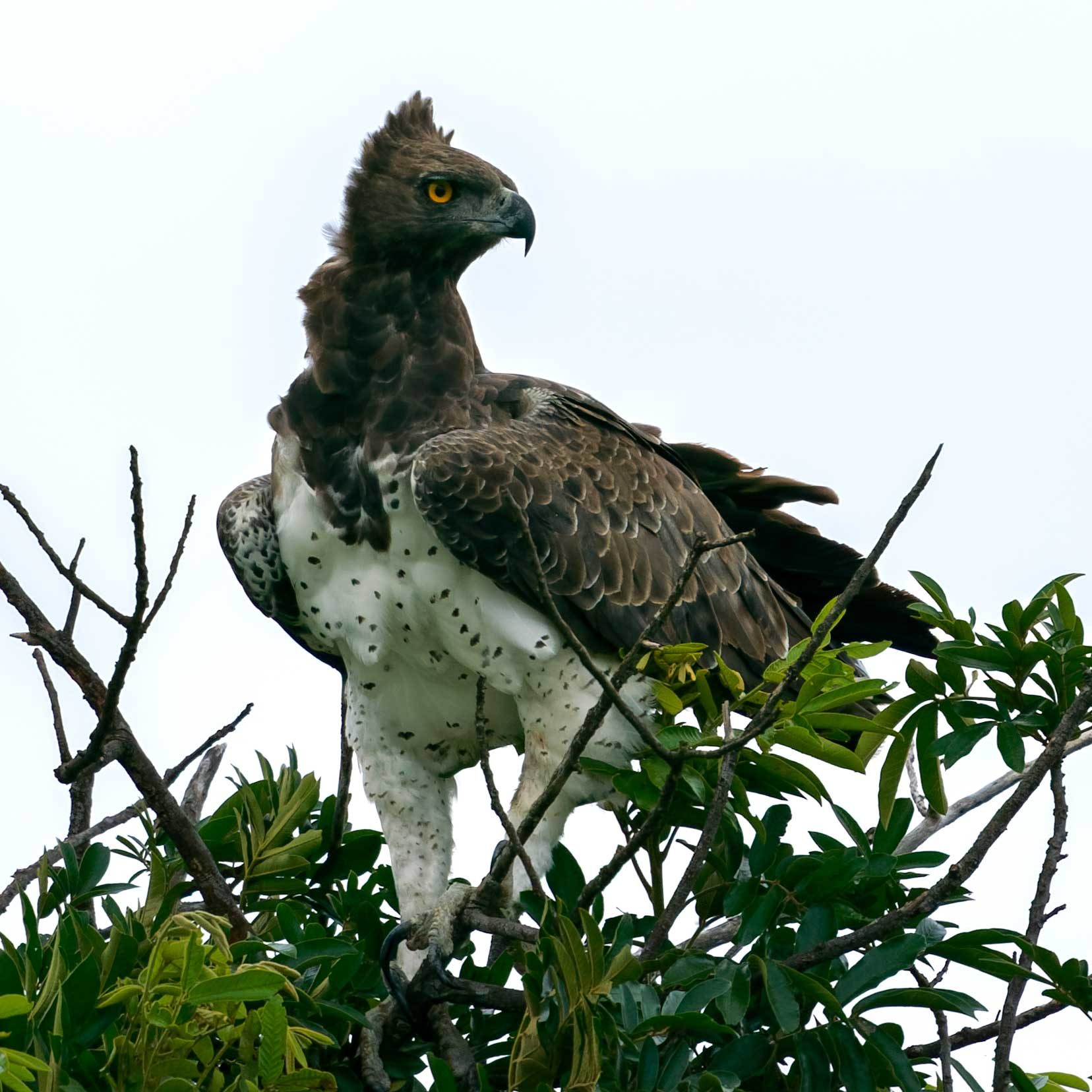
The Martial eagle has beautiful dark brown plumage fringed with white in places and piercing yellow eyes. It is classified as an endangered species by BirdLife International.
Photography Tip: Martial Eagle
Look to the treetops for perched birds and maintain a good distance by shooting with a long lens. I was lucky enough to spot this powerful Martial Eagle on the crown of a tree and waited until it took flight to capture these images.
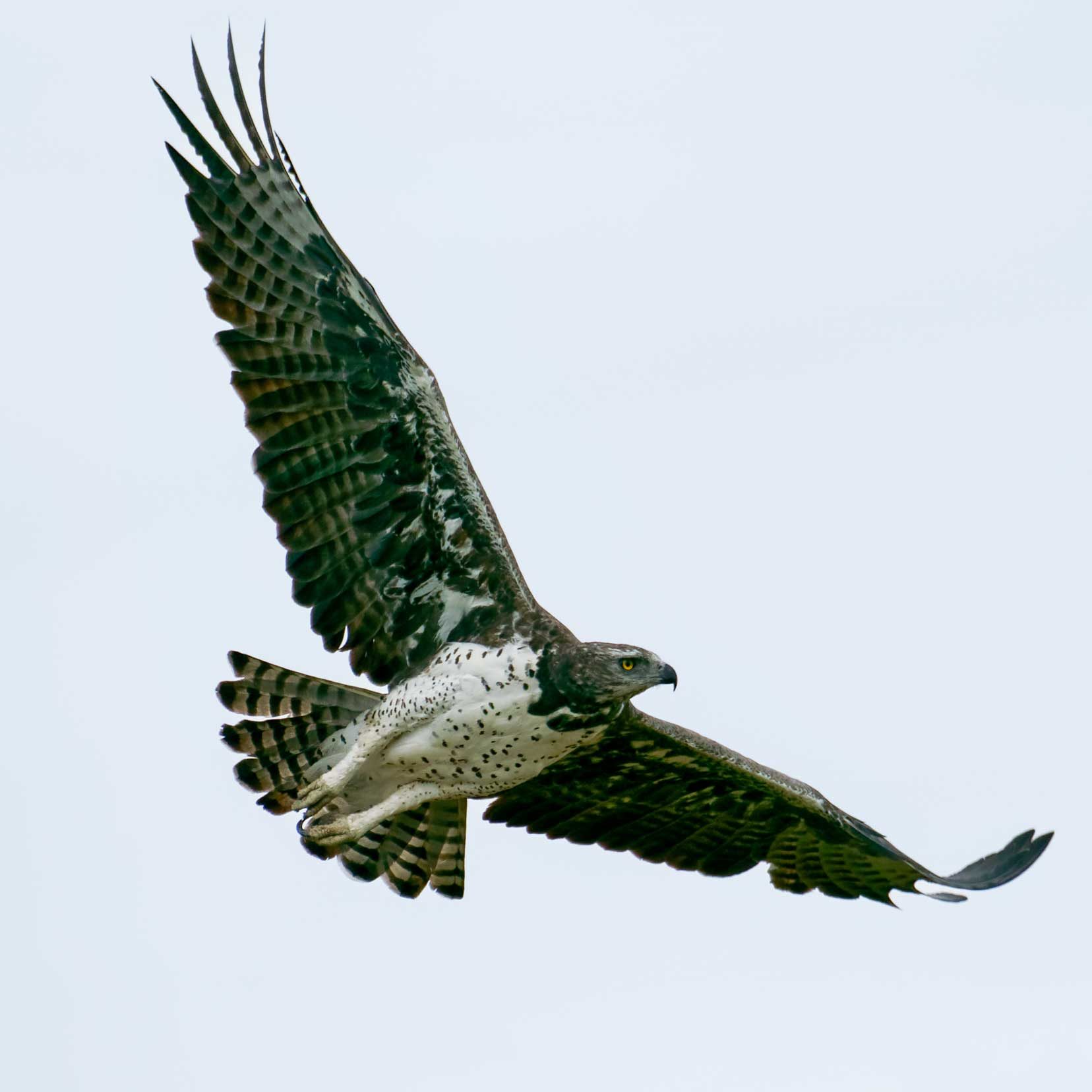
Lappet-Faced Vulture – The Ugliest of the Big 6
The cloaked villain or Lappet-Faced Vulture has folds of skin on its head thus earning the name lappet. With its pink/red face, dark brooding eyes and large beak, it definitely plays the villain’s part well.
The Lappet-faced vulture is an old-world vulture relying on eye-sight to spot its food. It is mainly a scavenger but will also prey on small animals. It is listed as endangered.
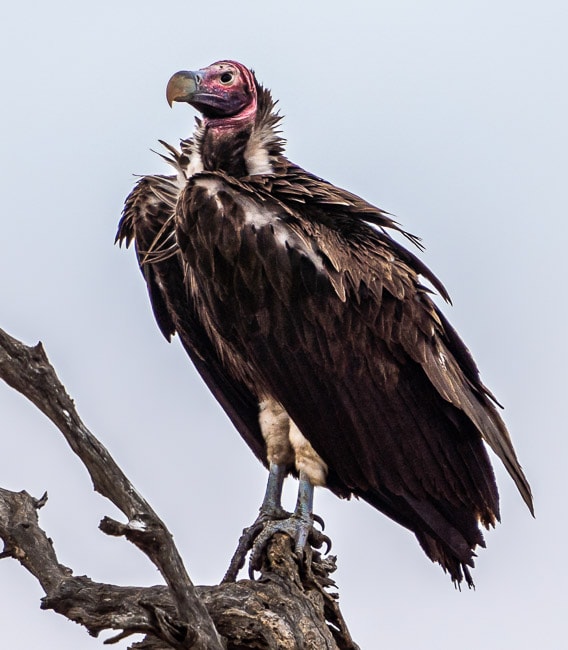
Photography Tip: Lappet-Faced Vulture
Look to the skies and watch for slowly circling birds that may indicate a kill below. Vultures will also group together in dead trees to rest, making for some unhurried shooting.
As with all bird photography, using a long lens will bring the action to your doorstep. Using good quality binoculars (10×42 is a good all-rounder) to search for birds is absolutely necessary.
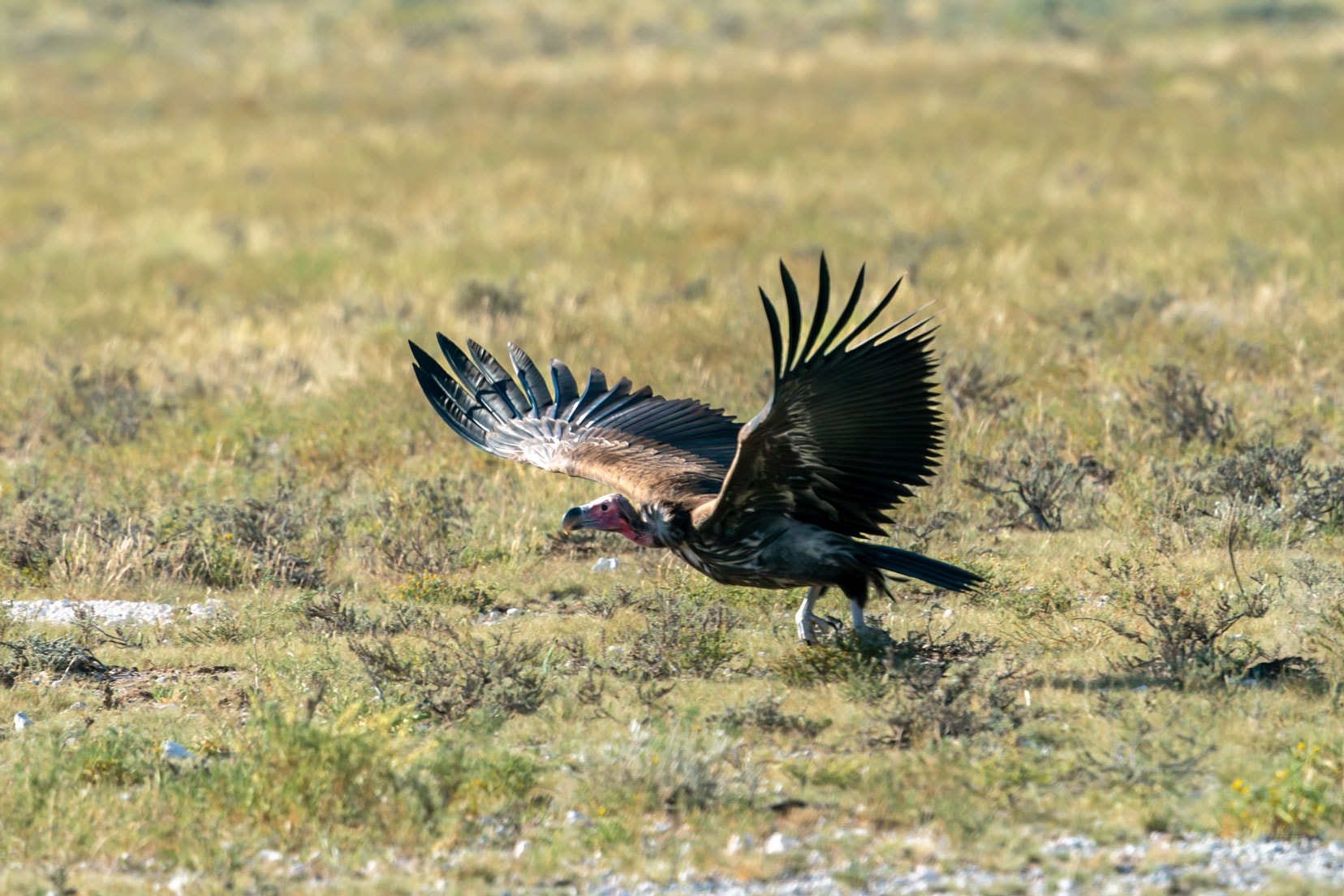
Pel’s Fishing Owl – The Most Elusive of the Big 6
As mentioned, Pel’s Fishing Owl is nocturnal, greatly decreasing the chances of a sighting during the day. especially as Kruger only allows night drives under special conditions.
It is the second largest owl in Southern Africa behind Verraux’s Eagle Owl and is commonly found near estuaries, rivers and lakes. The bird has rufous-brown feathers and bars across its plumage.
The image below is not ours, but it will give you something to work from.
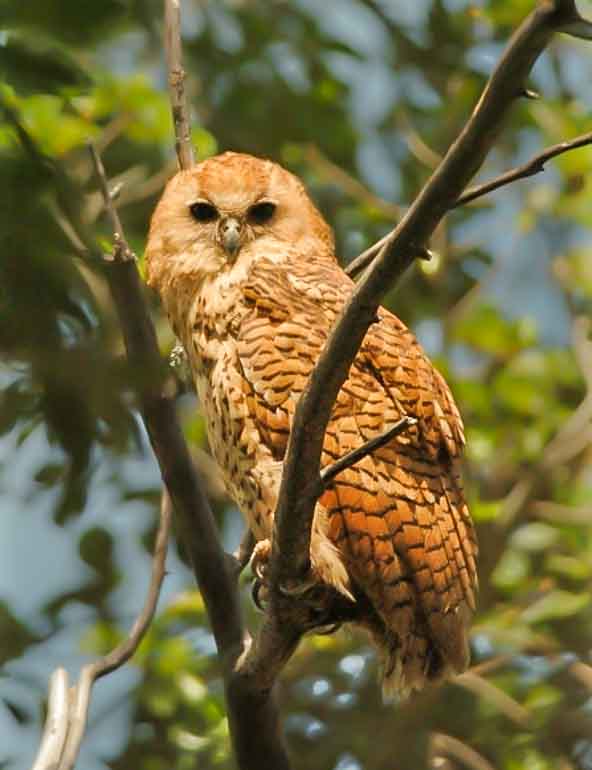
Photography Tip: Pel’s Fishing Owl
Join a night safari that follows the waterways to give yourself the best opportunity to spot a Pel’s Fishing Owl.
Saddle-Billed Stork – The Best Makeup of the Big 6
The Saddle-billed stork is the tallest stork in the world at 1.5m with long legs that ply the waterways, often with a beak immersed in the water, searching for food. Can you tell which of the two birds below are the male and female?
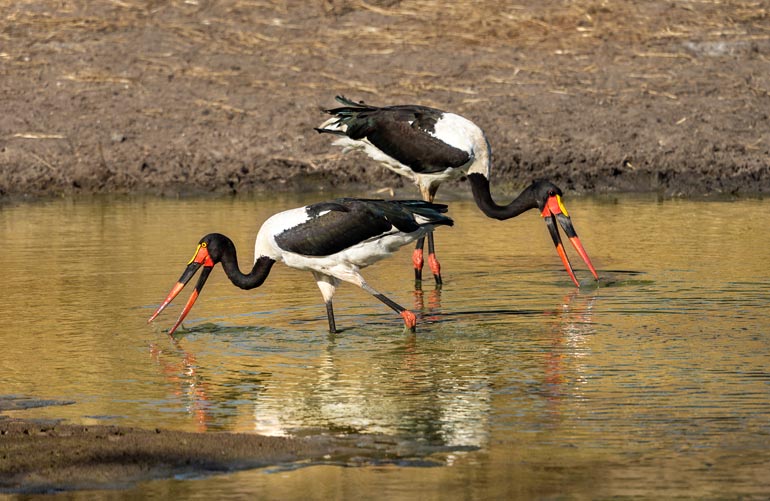
The male has dark eyes and small dangling yellow wattles, whilst the female has bright yellow eyes and no wattles. Both sexes have red knee bands.
It is listed as endangered but only in South Africa as there are fewer threats (mainly urbanisation) to the birds existence in the other African countries.
Photography Tip: Saddle-billed Stork
The stork is not a shy bird when it’s in the water meaning you can get reasonably close for those close up detailed shots. Often these birds are in pairs or a group which multiplies your chances of a good shot.
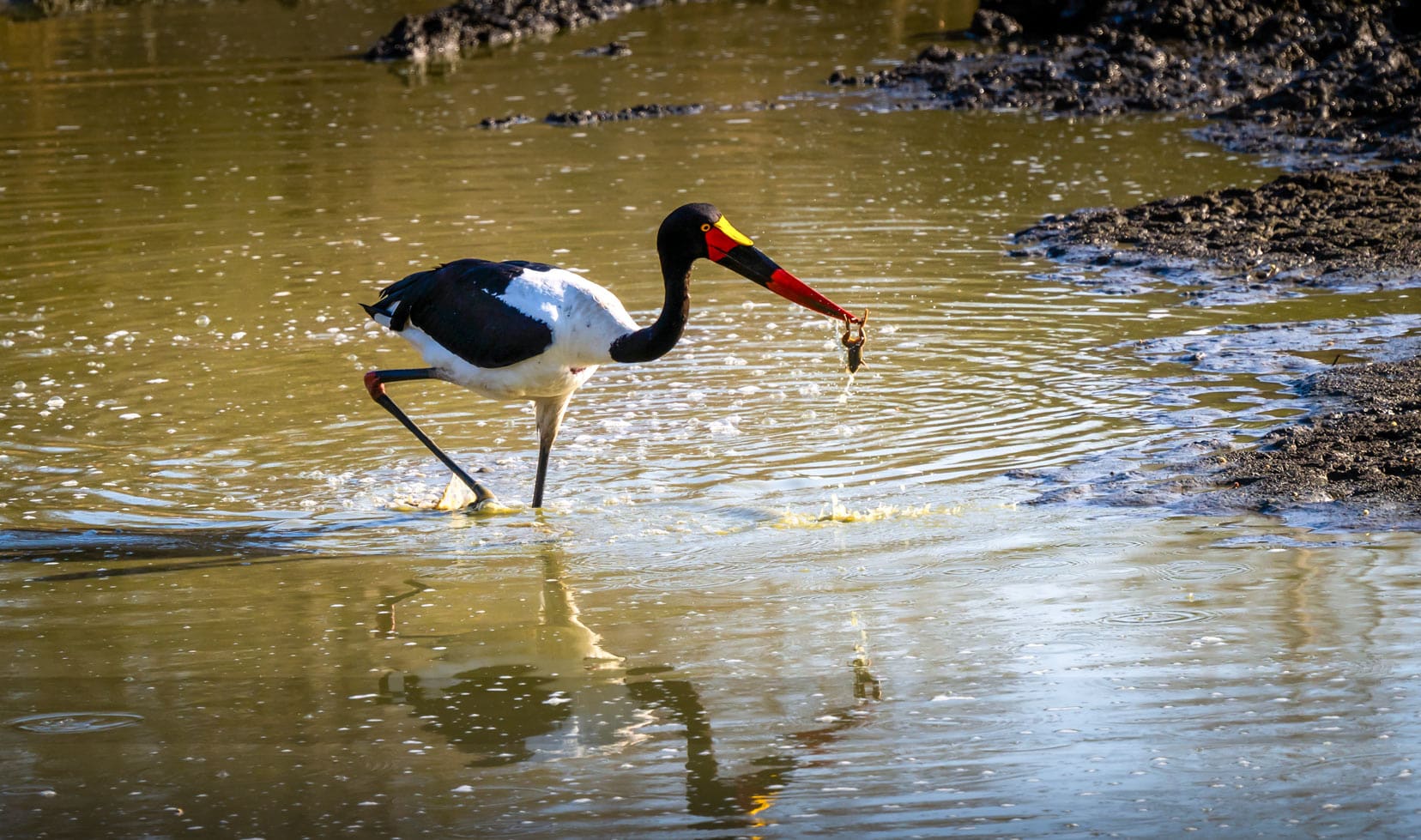
Southern Ground Hornbill – The Most Distinctive of the Big 6
It’s common talk, the Southern Ground Hornbill isn’t a looker, if you know what I mean, but it sure is distinctive. The long, dark eye-lashes, wide-open searching eyes, vivid red colouring and head full of beak make it slightly laughable to look at but no, its an effective killing machine.
Its specialty is hunting snakes but is also partial to small mammals such as hares. Yes, a formidable bird.
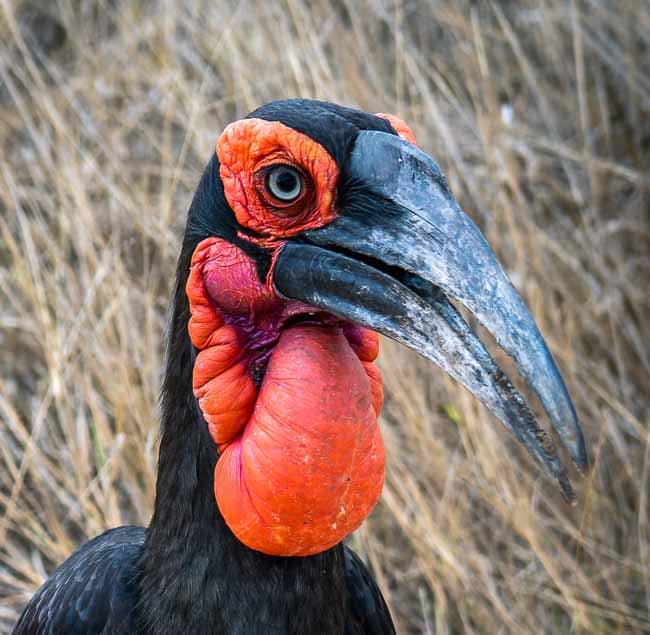
Often we see them in pairs or groups, they walk with head moving side to side, searching for prey in the grass. At night, the birds roost in the trees.
This species is classified as endangered.
Photography Tip: Southern Ground Hornbill
When on safari, look for the bobbing flashes of red in the grass. We’ve been lucky to have a few Southern Ground Hornbills pass right by our car doors, but I’d say that’s just luck.
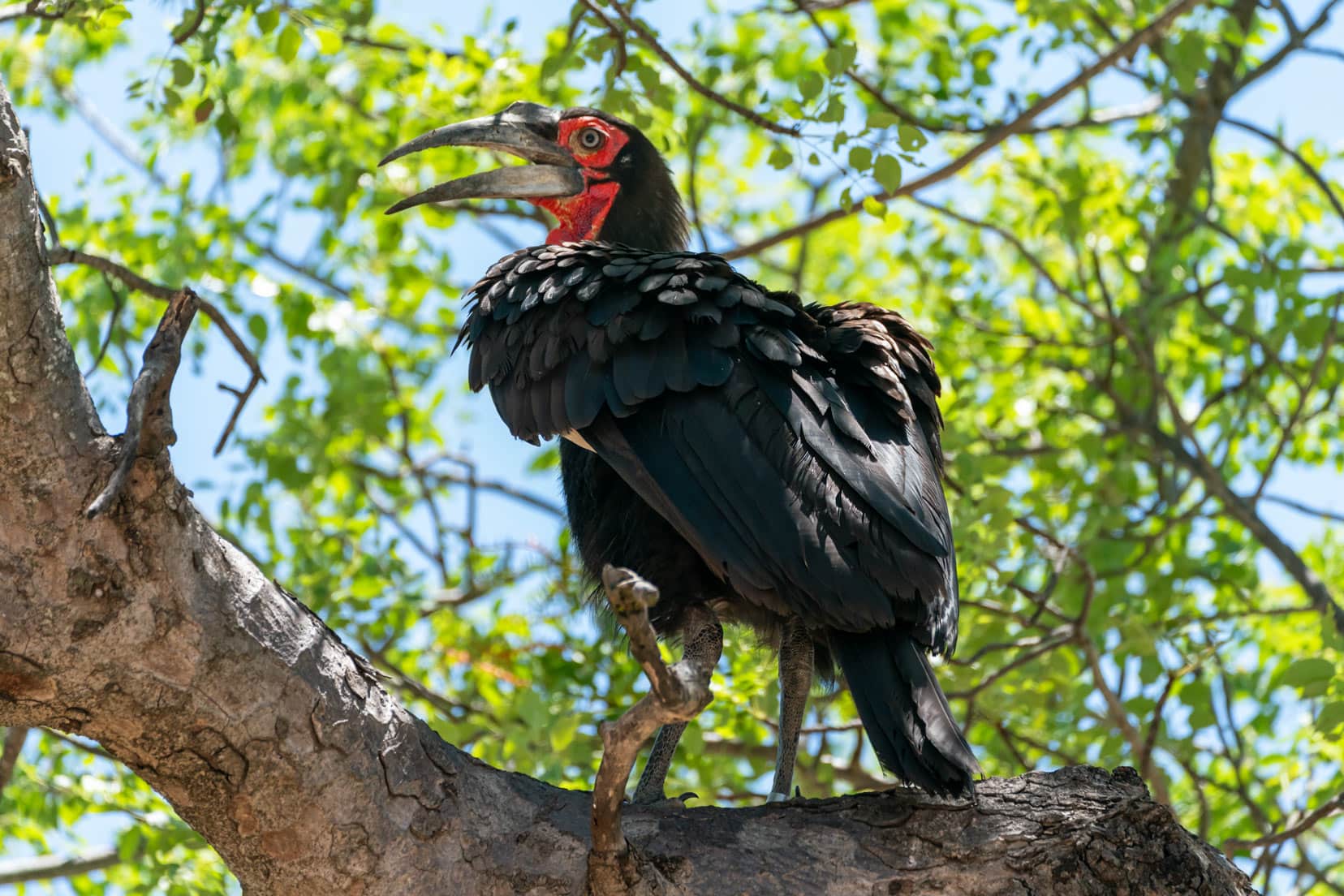
Video: Kruger National Park Birds
Below is some of our Kruger Birds video footage, giving you a real-life taste of what Kruger can offer.
Kruger National Park Bird Photos
Most of our images of birds in the Kruger National Park were captured from the car window. However, when inside the confines of the rest camp, we could wander about safely on foot with our cameras.
The birds were drawn to the camps by the scraps of food left by campers making it easier for us to get closer than we normally would.
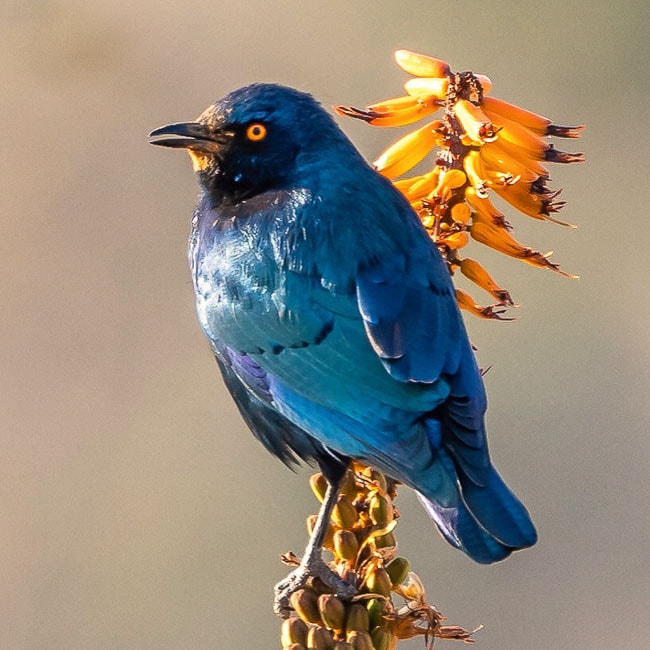
Spotting birds from a moving vehicle can be a challenge; however, the best tip I can share here is to keep the vehicle speed low. Stop and turn off the engine if you see something you want to photograph.
This minimises movement. Sometimes, the best shot won’t be presented immediately. Patience is key.
We always apply the above rules and find that it works well for us. Here are some of our favourite Kruger bird images.
Lilac Breasted Roller
The lilac-breasted roller is probably the most well-known of the five roller varieties seen in Kruger.

You can see why this little guy gets much attention — it’s been blessed with stunning coloured plumage.

The rollers like to sit in the trees and swoop down to feed on insects and fly back to their perch quickly. They often return to the same tree to scope out more insects, so if you play the waiting game, there are good opportunities for photography.
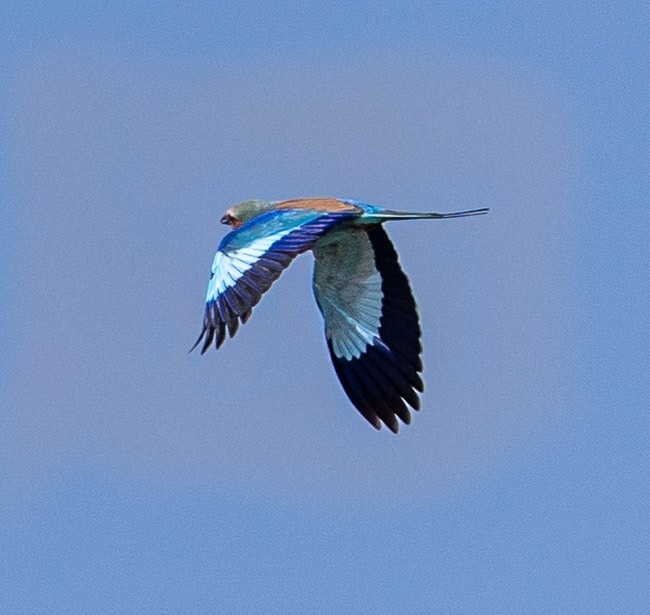
European Roller
The European roller is a seasonal visitor to Kruger and is found between November and March during its non-breeding season.
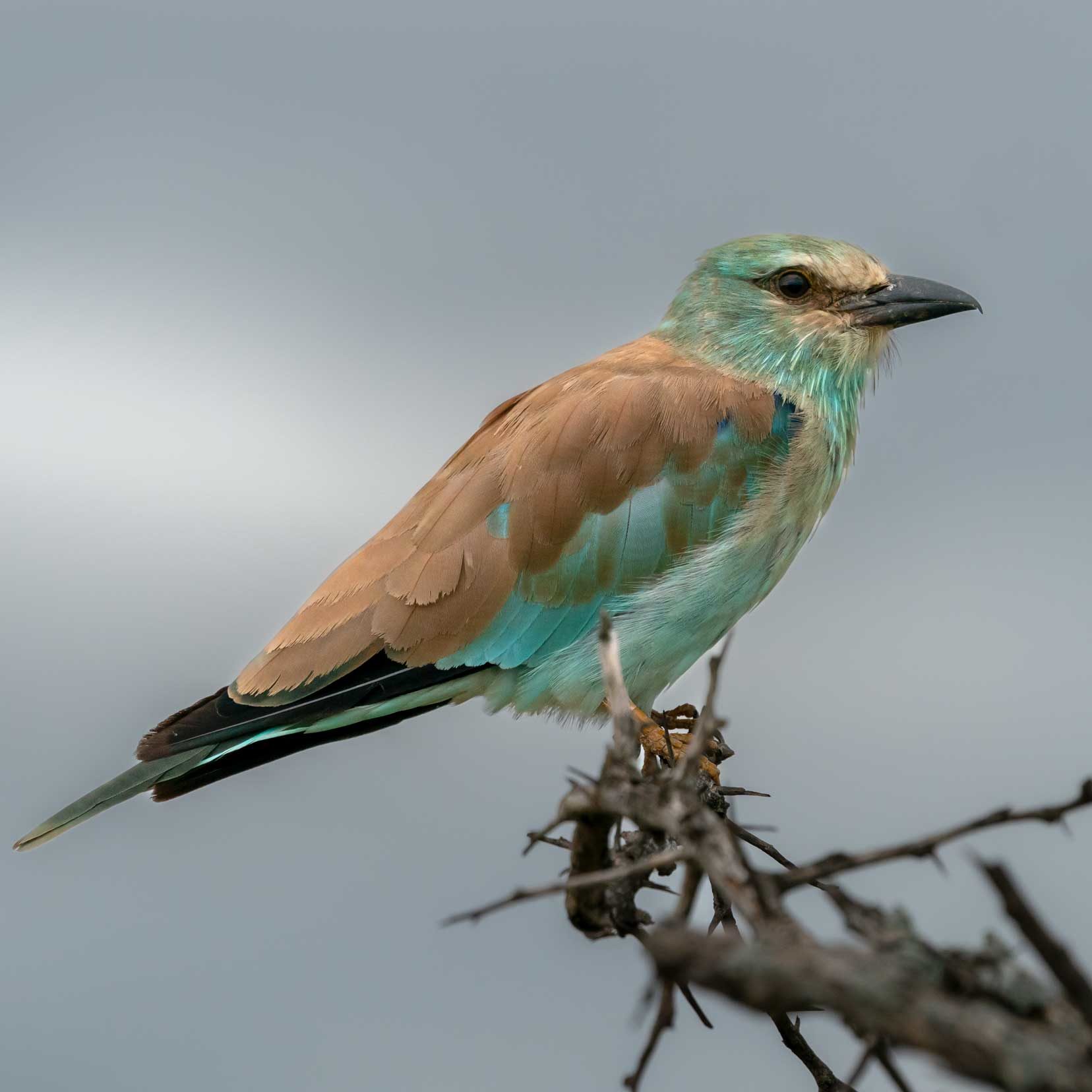
It has gained its name from the rolling aerial acrobatics it performs during territorial flights and courtship.

It, too, has stunning and distinctive coloured plumage but not as eye-catching as the lilac-breasted roller.
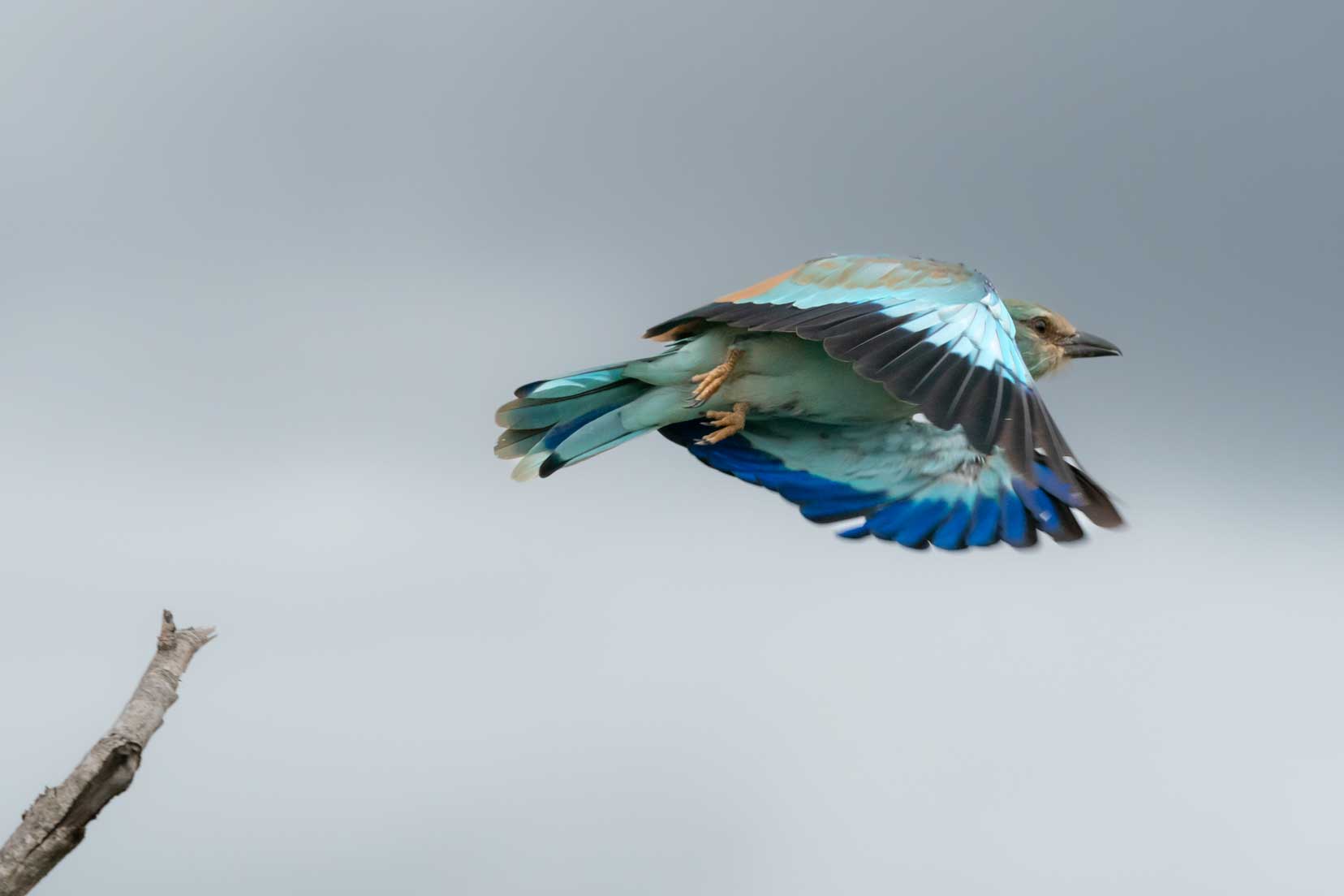
Southern Red-Billed and Southern Yellow-Billed Hornbill
Both varieties forage on the ground for insects; with the yellow hornbill adding fruits and seeds to its diet.
Distinguishing the different varieties of hornbill is accomplished by simply observing the bill colour.

The yellow-billed hornbill has a much larger beak and is in greater numbers than the red hornbill and is not a particularly shy bird.
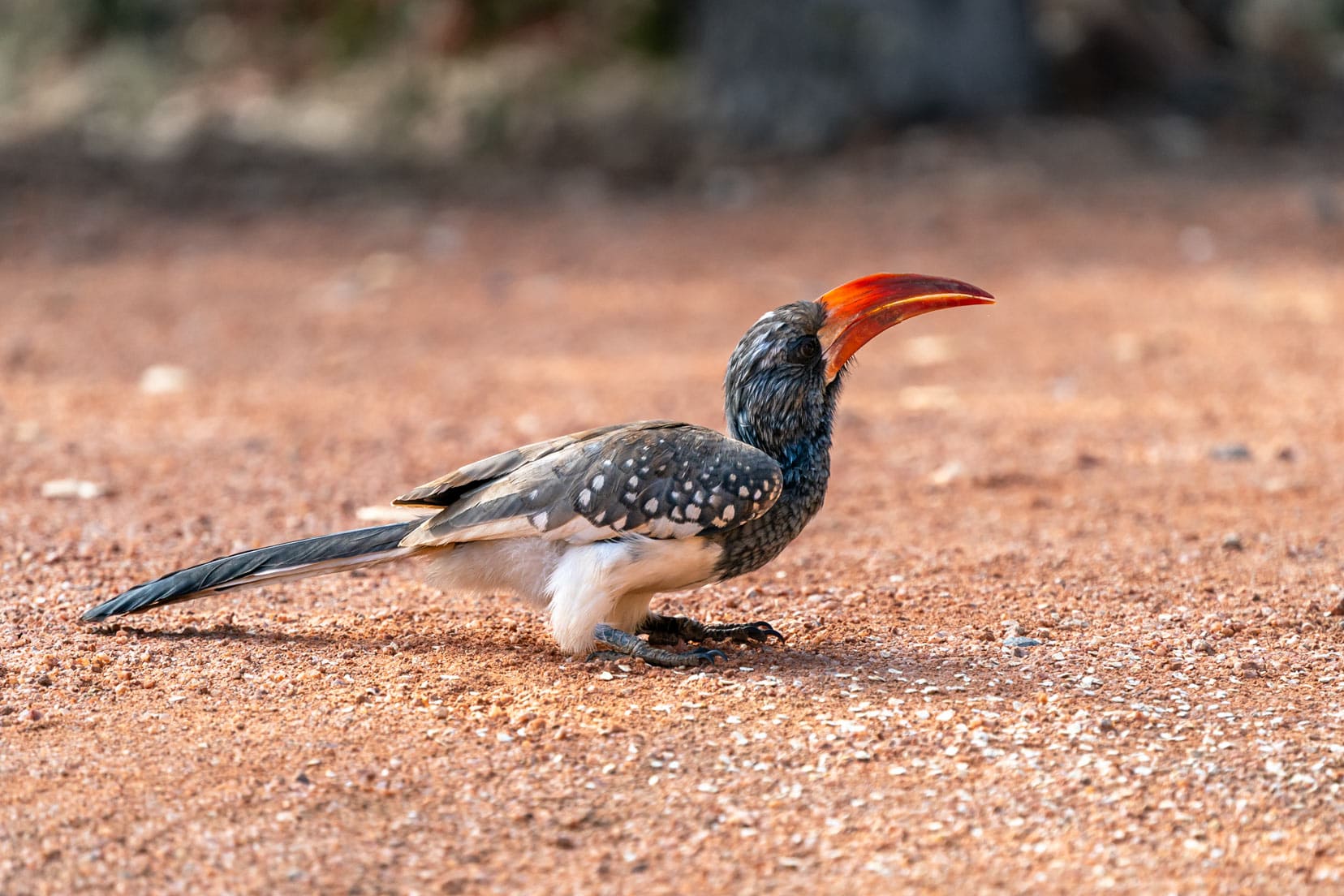
Both are common Kruger Park birds and year-round residents.
African Grey Hornbill
The African grey hornbill forages within trees, with its diet consisting of fruits, leaves and small reptiles.
It has a two-tone grey and ivory-coloured bill and is a year-round Kruger resident.
It is commonly found in Kruger but not in the same numbers as the yellow-billed hornbill.
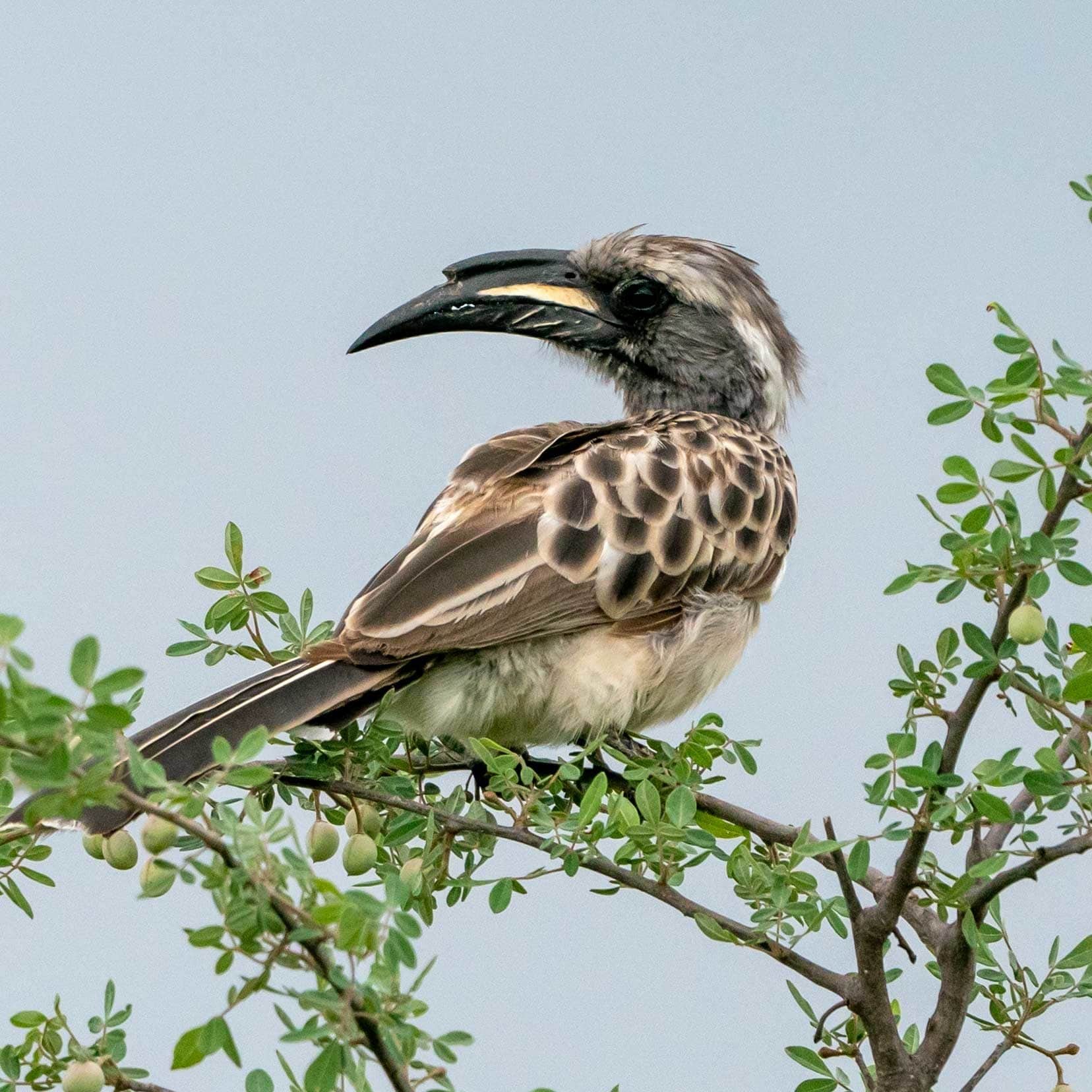
White-Fronted Bee-Eater
This cute, multi-coloured white-fronted bee-eater is a resident of Kruger and easily distinguished from other bee-eaters by its black ‘eye mask’ and red band around its throat.
Although its preferred diet is honey bees, it will eat other insects.
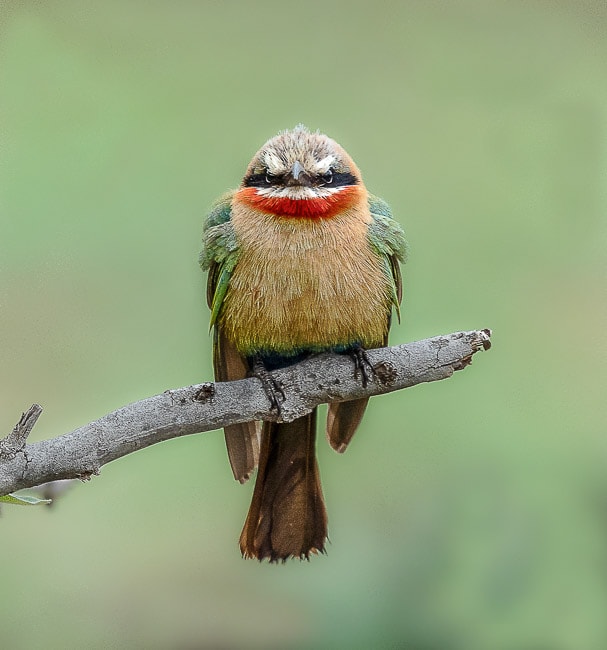
During our safari drive, we would park up and watch them in the trees close to the water, waiting for insects to skim the surface so they could dive down and retrieve a meal.
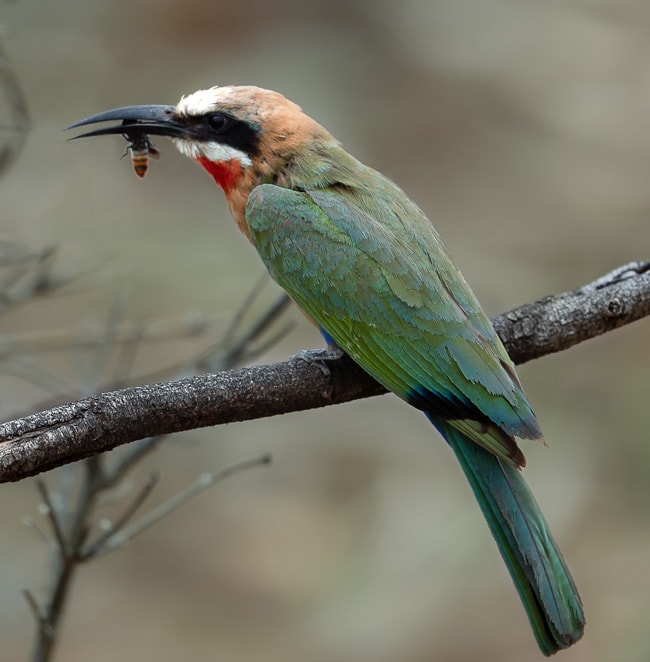
Malachite Kingfisher
The ‘cutie’ of this group has to be the malachite kingfisher. What dazzling and complimentary plumage. The kingfisher is found around rivers and dams.
Have you seen a malachite kingfisher’s head stay still whilst the body pivots when it’s perched on moving river reeds? How lucky were we to see it (take a look at our video).
You can see in the video that the malachite kingfisher has absolute focus.

Giant Kingfisher
The giant kingfisher likes to perch high up in the trees over the water. Its favourite food is crabs, and that powerful beak dispatches them easily.
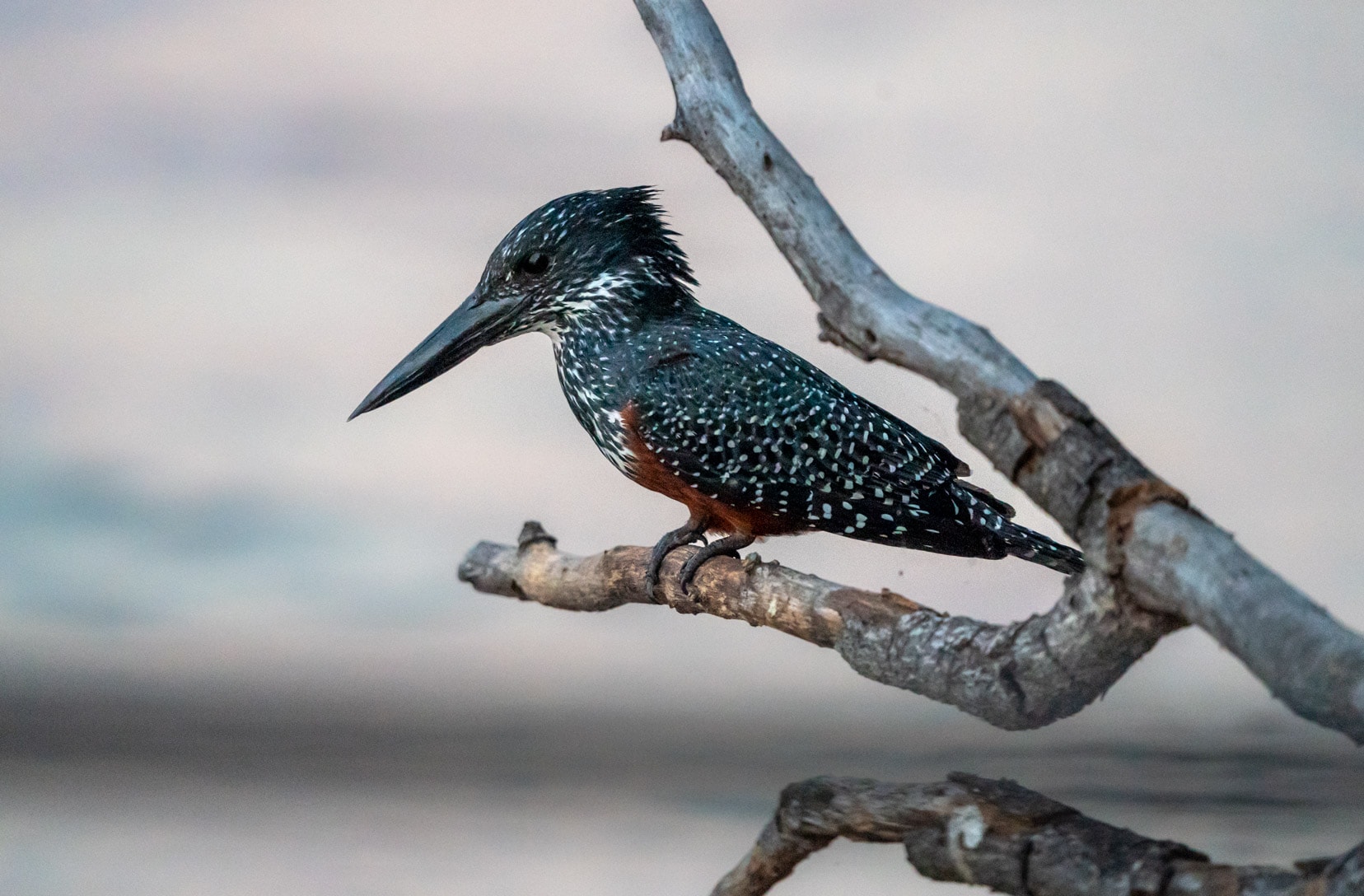
The male and female have similar colored plumage with the male’s brown patch higher up on its chest than the female. It is sometimes said that her brown represents an apron and his brown waistcoat.
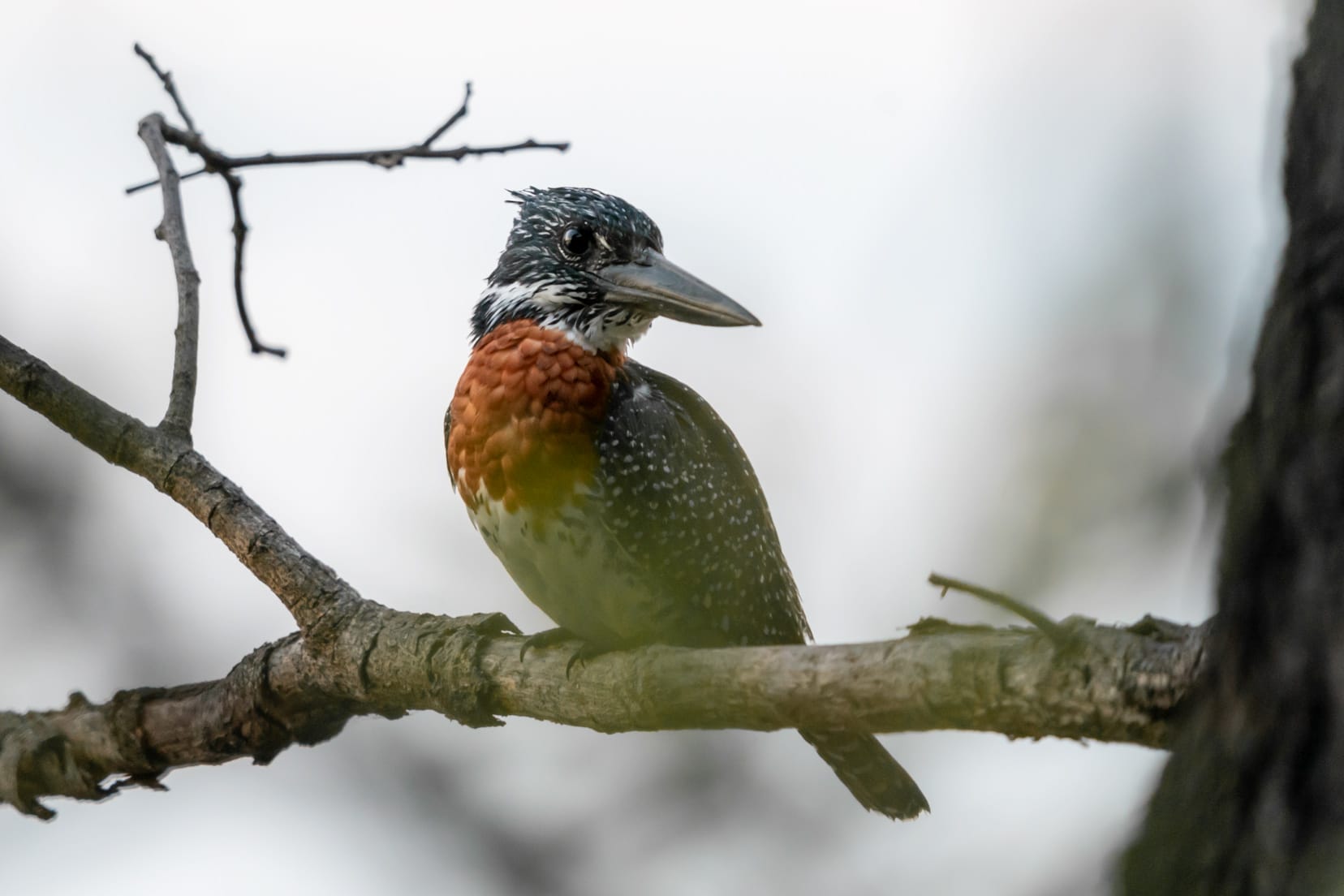
Pied Kingfisher
We’d often see the pied kingfisher hover about 10m above the water, with head down before plunging head first in search of fish.
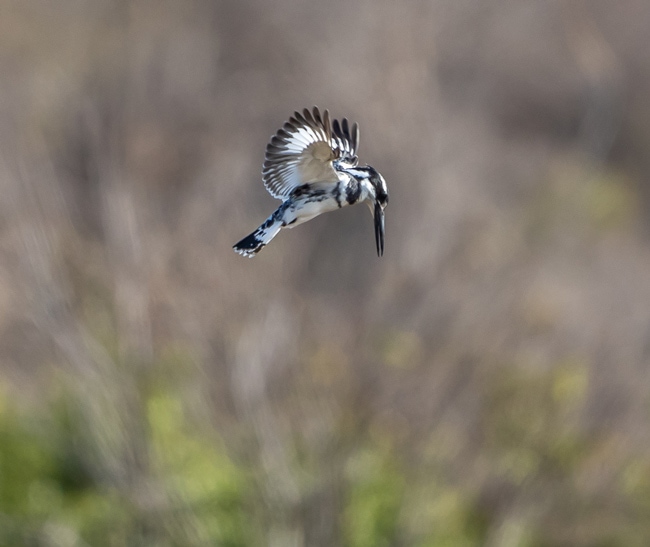

Brown Hooded Kingfisher
Although it wears the badge of a kingfisher, the Brown-hooded kingfisher actually does not include fish in its diet. Its preferences are insects, frogs and reptiles and is found in savannah and parklands.

Raptors
In the vast expanse of Kruger National Park, the majestic often soar high, commanding the skies with their formidable presence. These birds of prey, ranging from the iconic African Fish Eagle with its haunting calls to the stealthy Martial Eagle, the park’s largest raptor.
We had fabulous sightings of the African fish eagle, tawny eagle, bateleur, African hawk eagle, and brown snake eagle.
African Fish Eagle
The African fish eagle has a very distinctive ‘cry’. We often saw them at high vantage points in trees over water sources, scanning for food. It has wing spans of up to 2.0m.
The image below is the parent that had just delivered half a catfish to its solitary chick at its nest, then flew a short distance away to enjoy the remaining half of the spoils.

Tawny Eagle
The Tawny eagle prefers savannah and feeds on mammals, reptiles and birds. It has a wing span of up to 1.9m.
Whilst driving through Kruger, we spied a tawny eagle in a tree staring hard at something about 40m in front of our vehicle. We stopped and had our cameras ready.
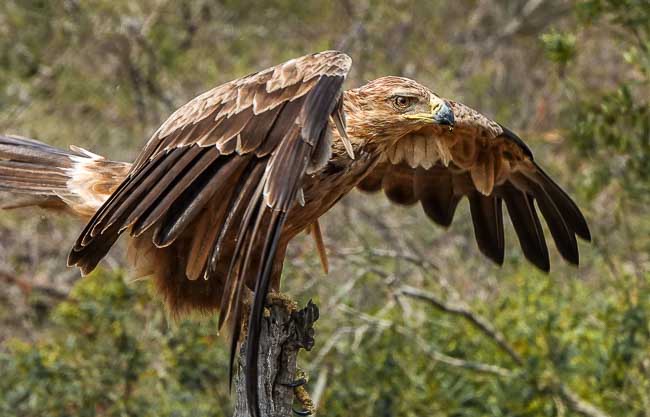
Soon enough, it swooped down to the road and started feeding on several wasps. A testament to the acute eyesight of the eagle.

Bateleur
Identifying the bateleur is easier than other eagles as the bird has multi-coloured plumage, orange legs and a reddish-orange beak. It is known to scavenge more food than it hunts.
The wing span reaches 1.8m.
The name bateleur is French and means a street performer. The birds in flight balancing of left and right mimics the act. The bateleur is partial to a wide range of food, including frogs, insects, mammals and birds.
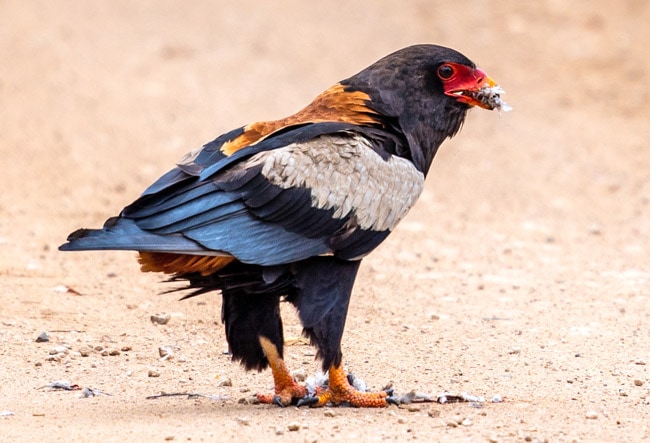
We saw a juvenile bateleur eagle and struggled for a while to identify it. Generally, a lot of juvenile birds have different coloured plumage and colourings that the adult version making them hard to identify.
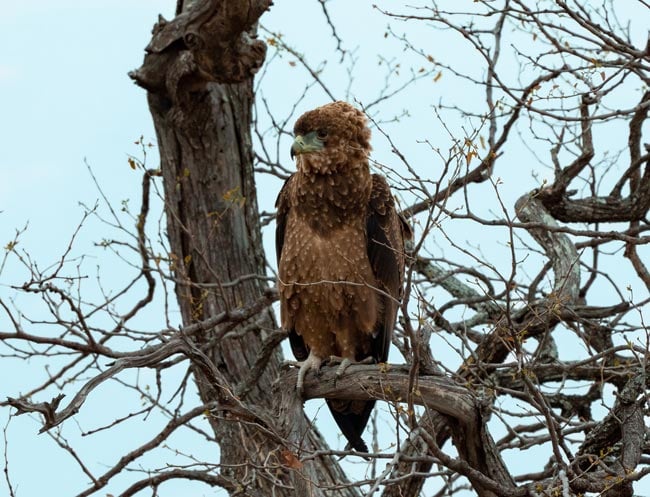
African Hawk-Eagle
The African hawk eagle is distinguished when in flight by a bar on its tail feathers and has small dark markings on the breast with wing spans reaching 1.5m. The eyes are bright yellow.
This bird feeds on a range of mammals and birds.
We observed a pair of African hawk eagles close to our Kruger camp and assumed that these were a mating pair as the breast feather markings were different.
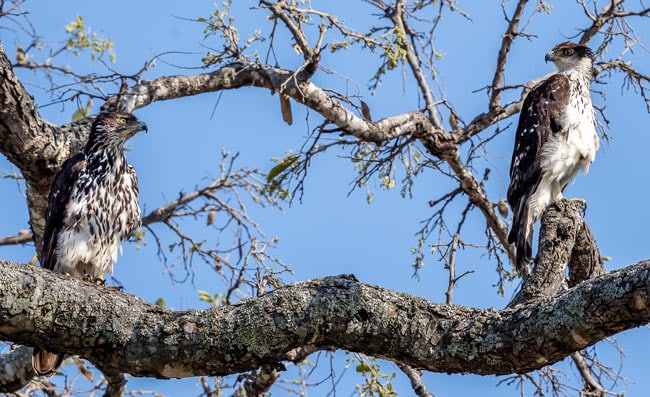
Brown Snake Eagle
The brown snake eagle is a medium-sized eagle frequently observed in Kruger and is distinguished by its all-brown plumage, piercing yellow eyes and banded tail feather with in flight.
The bird has a wing span of up to 1.5m and is the largest of the different snake-eagles feeding on snakes and mammals.
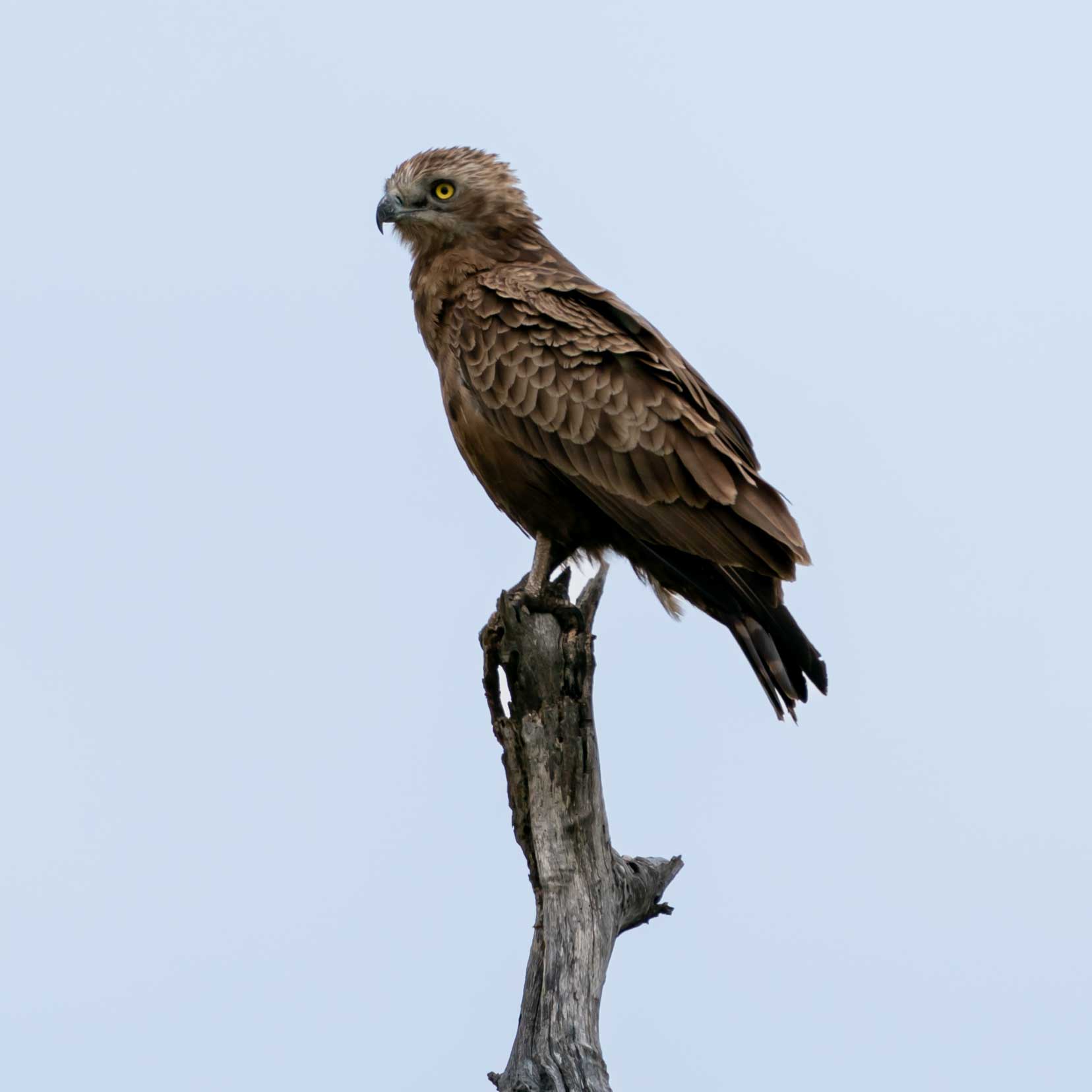
Yellow-Billed Kite
The yellow-billed kite is known for their slow flight and swivelling of their tail. The bird is quite common with wing spans up to 1.5m and has a varied diet of mammals, insects and carrion.
We noticed a yellow-billed kite tracking continually over our car whilst driving in Kruger and thought the bird might be waiting for us to scare prey out into the open. Clever bird if this was the case.
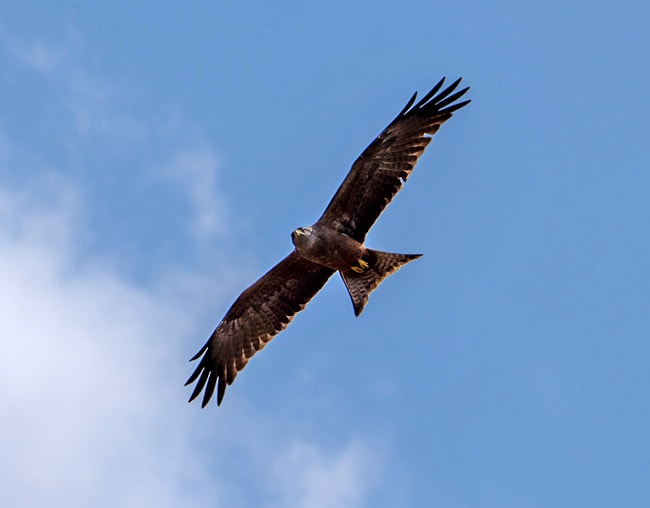
African Harrier Hawk
The African harrier hawk, also known as the Gymnogene, is easily distinguished from other eagles as it is often seen clambering around trees searching for birds and chicks.
We watched this African harrier hawk thoroughly search the openings in this tree, all the while being harassed by a starling who must have had a nest close by.
These hawks have double-jointed knees, which assist them in raiding tree holes for prey. Although normally seen with a yellow face, the face turns red when distressed, as seen below.
Adults have grey plumage, whilst juveniles have brown with wing spans that can reach a maximum of 1.5m.
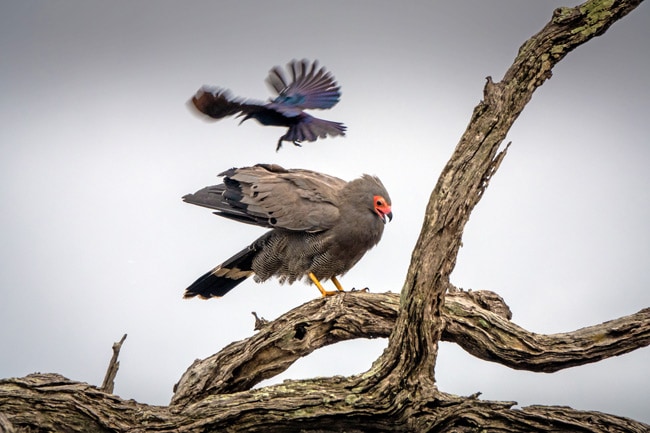
Verreaux’s Eagle Owl
The Verreaux’s Eagle Owl is the largest African owl and is distinguishable by its bright pink eyelids. This powerful bird feeds mostly on mammals and has wing spans averaging 1.4m.
In Kruger, we nearly drove past this Verreaux eagle owl as it was so well camouflaged on the trunk. Even with the noise of the diesel engine, he continued to snooze, not batting an eyelid.
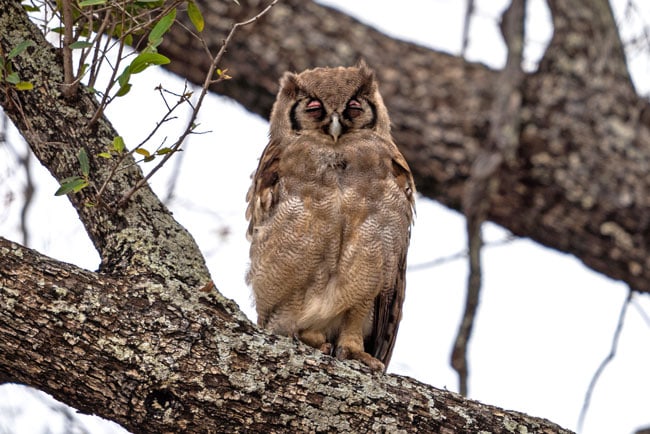
Pearl-Spotted Owlet
The Pearl-Spotted Owlet is one of the smallest owls in Africa, with wing spans of just 0.4m. Yes, a real little cutie. These birds have a distinct call of sharp, short ascending pitch.
Not sure if this little guy deserves a place amongst the raptors, but pearl-spotted owlets feed on small mammals, lizards and insects. We zeroed in on this tiny pearl-spotted owlet by tracking his calls.
Interestingly, the species has a pair of black spots on the back of its head as a form of protection to deter attacks from larger birds.

Vultures
Whether circling overhead or milling about a carcass, vultures are not as macabre as portrayed. They are scavengers preferring fresh meat to old. There are two types of vultures: old world and new world.
Africa has old world vultures whilst America is home to the new world vultures.
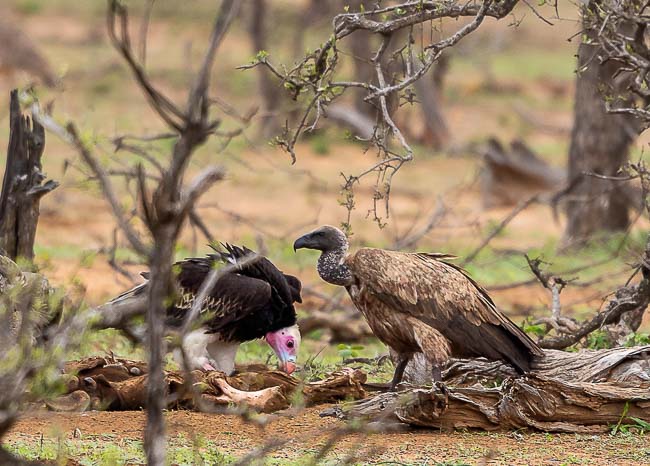
Did you know that all vultures have unfeathered heads, which aids in keeping their heads clean of blood and carrion when feeding?
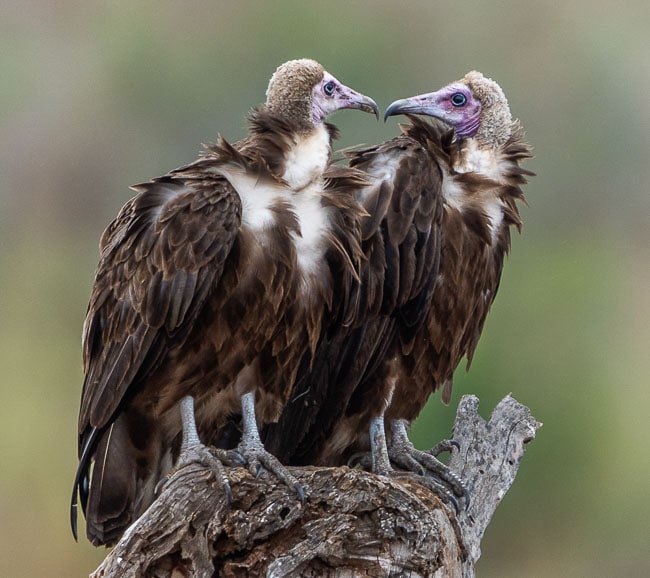
Green Wood Hoopoe
The green wood hoopoe is a common bird with beautiful plumage and often scans the trees for insects, fruit and seeds.
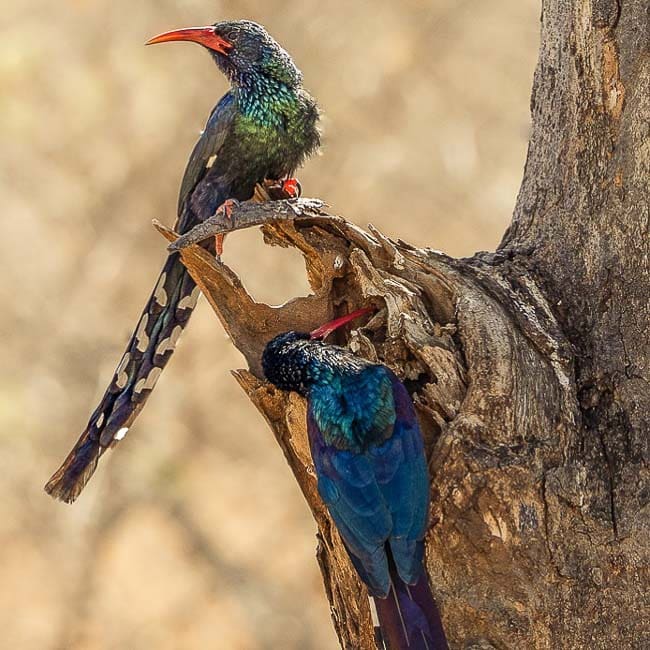
Blue Waxbill
The blue waxbill is a common but beautiful little bird that feeds predominantly on seeds. The male has more blue than the female.
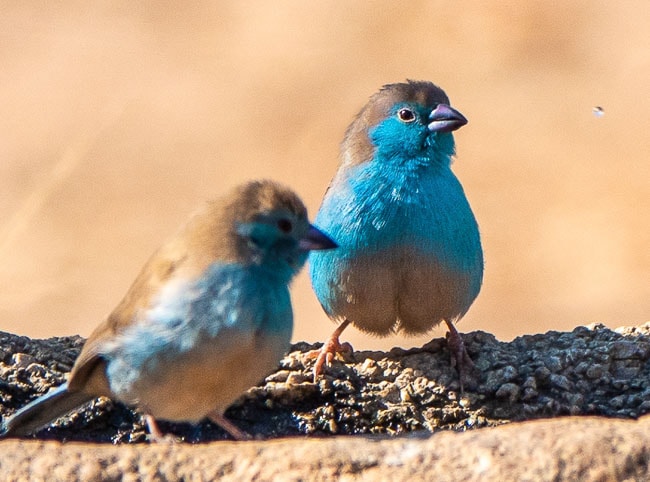
African Spoonbill
The African Spoonbill is common and prefers quiet areas, moving left and right with its beak in the water, searching for food.
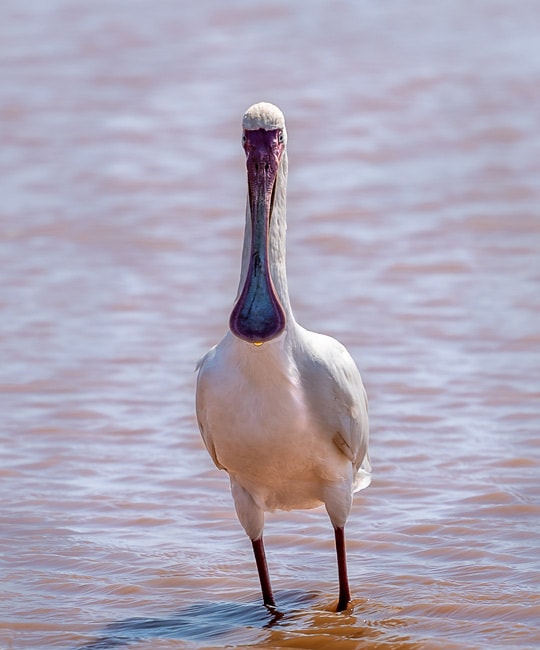
White-Bellied Sunbird
The white-bellied sunbird feeds on the nectar of various flowering plants. The male (seen below) is brightly coloured, whereas the female is plain brown.
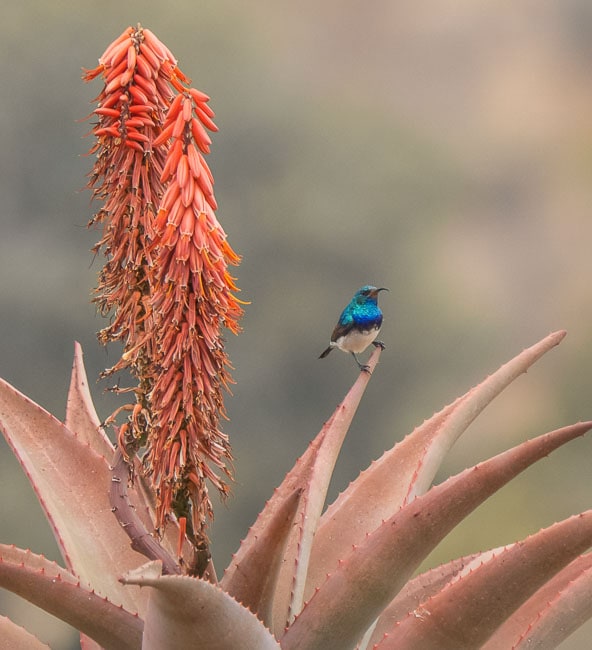
Yellow-Billed Oxpeckers
The Yellow-billed oxpecker is one handy little bird. It eats ticks and insects, which helps the animal kingdom immensely.
You can often see oxpeckers pecking the skin on buffalo, giraffe and impala. A handy tip when on safari, when you sight an oxpecker in a bush, this indicates the presence of an animal nearby.

Grey Heron
The Grey Heron is a large bird with distinct plumage and a height of up to 1.0m. It’s commonly found in and around streams and dams.
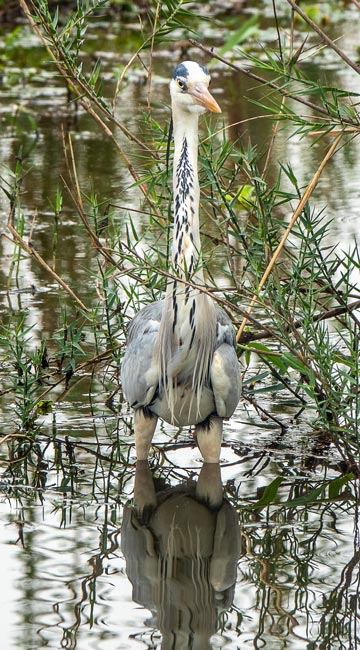
Lesser Striped Swallow
The lesser striped swallow is a small bird that uses its skills to catch insects in flight however will also forage on the ground for seeds and grubs.
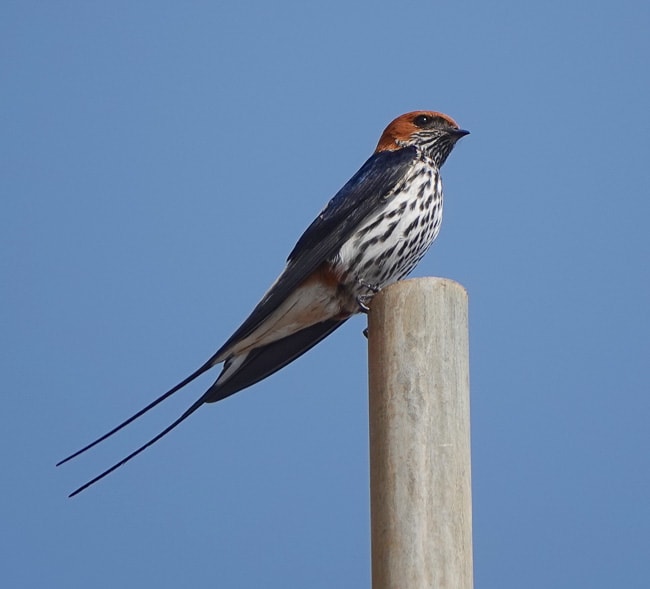
Black-headed Oriole
The black-headed oriole is commonly seen where there are plenty of trees, preferring to eat seeds and insects.
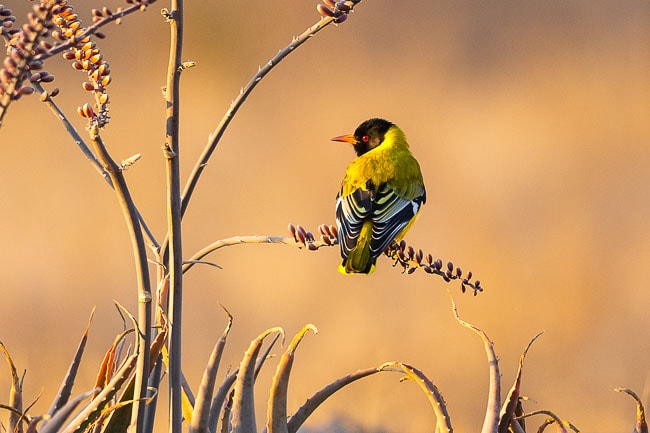
Crested Barbet
The crested barbet is a multi-coloured bird with very distinctive plumage. It is common and feeds on seeds and insects.

Green-winged Pytilia
The green-winged pytilia have red faces and feed on seeds. They are a common bird in Kruger’s National park.
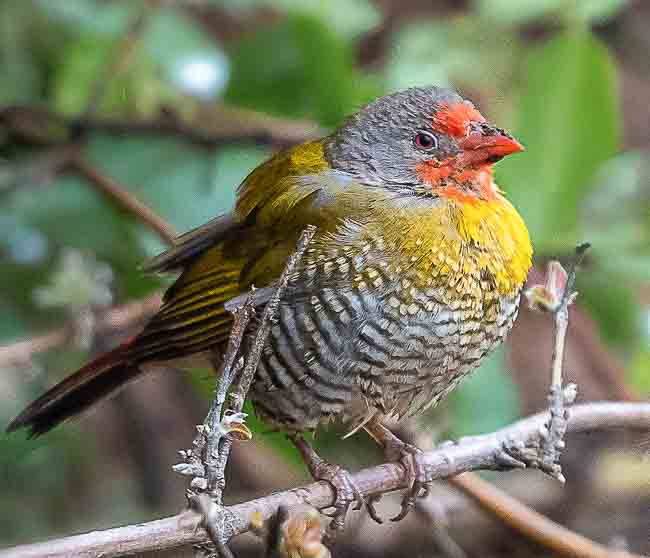
Photographing Kruger National Park Birds
Before the rains, we travelled through Kruger National Park in winter and spring. The countryside was very dry, and the sparse foliage offered good opportunities to spot birds taking refuge in the branches. Bird-watching during the dry season is at its easiest. This applies to most of Southern Africa.
My photography gear comprised a Sony a7III and a Sony 200-600mm telephoto lens. A telephoto lens is essential when photographing birds of the Kruger National Park.
You can shoot from a distance without scaring the bird. Using a high frame rate camera with a high shutter speed will definitely give you more opportunities for ‘keepers’.
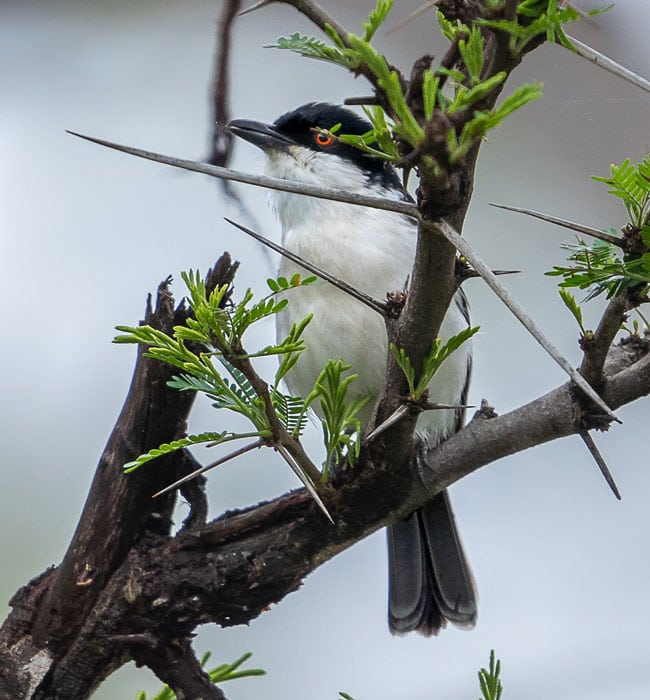
When capturing images of birds in the open or in flight, I set the Sony camera to continuous auto-focus so it could do all the tracking work. This works well until you encounter obstructions, such as birds in the bushes.
Then, I reverted to Direct Manual Focus (DMF), which allowed me to manually push the focus plane onto the bird itself. Had I left the camera in auto, it would often focus on the branch in front and, therefore, miss critical focus, resulting in a soft image of the bird.
Whilst using DMF, I also activated Focus Peaking which confirmed the focal range was right on the subject.
African Bird Identification in Kruger
Being full-time travellers, it’s not feasible for us to carry around armfuls of wildlife and travel books.
However, it’s not a problem nowadays, as reference material is easily downloadable to a tablet or phone. The go-to guides we regularly use in Africa are country travel guides, bird/animal identifiers and digital maps.

Especially helpful when on safari when identifying different bird species is the KrugerExplorer app. This comprehensive app has information specifically related to Kruger.
With over 500 bird species in the park, why wouldn’t you want this as a quick reference tool? The app includes info on flora/fauna identification, the national park driving routes (only the route overview, not active GPS navigation), campsites, and wildlife sightings.
It is definitely money well spent.
Once inside Kruger, you’ll need to know physically where you are. On occasions, drivers will share their sighting positions with you then will need to navigate to that location. We use and love the Tracks4Africa Guide app.
The app superimposes real-time position on a detailed map to target your exact position. The app also includes handy information such as attractions, campsites, fuel stops, different route options, route terrain and much more.
The Tracks4Africa app is designed to work offline and covers most Southern African countries.
Where is Kruger National Park?
Kruger National Park is nestled in northeastern South Africa, stretching across the provinces of Limpopo and Mpumalanga. It runs along the national borders of Mozambique to the east and Zimbabwe to the north.
This iconic park is renowned for its vast landscapes encompassing nearly 2 million hectares, making it one of Africa’s largest game reserves. The Kruger to Canyons Biosphere Reserve is listed as UNESCO heritage site.
Want to see more of South Africa’s great wildlife? Read more about 🦜common birds in Kruger National Park and wider South Africa, plus our abundant 🐆 Kruger animal sightings.
Birds in Kruger National Park … That’s a Wrap
Kruger National Park hosts a huge variety of birds and its not surprising that people flock from around the world to see what it has to offer. From the tiniest sunbirds to the majestic birds of prey, every bird has earned its place within the delicate ecosystem of Kruger Park.
Have you had some great bird sightings in Kruger National Park? Are you passionate about birding? I would love to hear about some of your memorable sightings.
Drop us a line or leave a comment below.
Pin and Save for later
YOU MAY ALSO BE INTERESTED IN READING:
- Safari Accessories – The Absolute Essentials
- Exploring Kruger’s lesser known Neighbour: Life in Klaserie Nature Reserve
Planning Your Travels?
These are the travel resources we recommend and use when planning our trips.
- 🚘 Car Hire: We use DiscoverCars.com
- Motorhome/Campervan Rental: We highly recommend the Motorhome Republic
- 🪪 Order your International Driver’s Licence online here
- 🛏 Book Accommodation: We use Booking.com to find accommodation that suits our budget
- 🐶 Pet Sitting/Pet Sitters: Check Out TrustedHousesitters here (Use our Discount code: LIFEJOURNEY25 for 25% off. )
- Activities and Experiences: Get Your Guide and Viator
- Travel Insurance: Safetywing or World Nomads
- 🥾 Travel Gear and Accessories: Check out our top picks here — Lifejourney4two page on Amazon
For a more thorough list, visit our Travel Resources page here.

